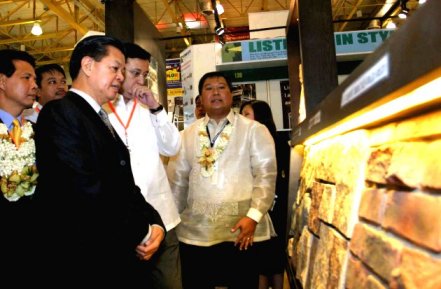|
Ms. Ronadale Zapata
83321148/8334507
VP
rallies support for socialized housing for poor
KABAYAN
BELIEVES ROBUST CONSTRUCTION INDUSTRY IS SIGN
OF HEALTHY ECONOMY
13 November 2005
Vice President Noli ‘Kabayan’ De Castro, concurrent Chairman of the Housing and Urban
Development
Coordinating
Council (HUDCC), underscored the
importance of the local construction industry especially its contribution to job
employment and a healthier
economic state in his speech before participants and guests of the PHILCONSTRUCT
2005 held at the World
Trade Center. The event was led by organizer Philippine Constructors
Association, Inc.

VP AT THE PHILCONSTRUCT 2005
EXHIBITION. Vice
President and concurrent HUDCC
chair Noli ‘Kabayan’ De Castro
comes across the new look of
Stone Age cobblestone while visiting the exhibits at the 15th Phil. International Construction
Equipment and Building
Materials Exhibition and Tech Forum (PHILCONSTRUCT
2005) held at the World Trade Center, Pasay City. With the VP are (from left):
HLURB Commissioner Romulo
Fabul; HGC Pres. Bong Bongolan;
Pag-IBIG Pres. Romero Quimbo and Emilio Tumbocon of Philconstruct
2005. (OVP photo by Egay Montaña 11/13/05)
The Vice
President mentioned that among the other sectors benefited a rising construction
industry are suppliers and
sellers of cement, steel bars, wood, nails, iron sheets and other construction
materials. Also benefited is
the manual labor sector as
construction is a labor-intensive activity. For a major housing project could give
employment to more than a
million urban and rural construction workers. For example, to build a low-cost housing
unit, no less than eight
workers are needed for an estimated three weeks or a total of 124 man-days. And
after the house has been
built, painting and finishing touches are undertaken after which furniture and
other appliances are then
purchased.
Vice
President De Castro took the occasion to gently remind his audience that even as the
four-day trade show would
showcase the latest trends in construction materials, equipments and technologies,
they should also remember that
there are still many Filipinos
whose needs are very simple and basic: four sturdy walls, a roof with no leaks, and the
security of having a place to
call home.
Philippine
construction has truly gone a long way. And yet, the culture of crude, do-it-yourself
construction still exists
among our less-fortunate kababayans. Ang tinutukoy ko po ay ang mga tinatawag
nating informal settlers na
nagtatayo ng kanilang bahay sa mga lugar na hindi naman nababagay tirhan. Gamit
ang materyales na makukuha
nila sa tabi-tabi. Such is the landscape of poverty housing.
The Vice
President explained that these informal settlers build their shanties along
railway tracks, on esteros,
under bridges and other places they do not own. He sympathetically refers to their
attempt to have a roof over
their heads as a kind of construction dictated by necessity, desperation and
limited means.
He announced
that the national shelter program for both the informal and formal sectors is
incorporated in the medium
term Philippine development plan and that the housing needs of some one
million families for 2005-2010
would need 217 billion pesos with top priority going to the poorest of the poor
and 68 percent of the total
target dedicated to socialized
housing.
Faced with
these challenges, Vice President De Castro then courted support from the Philippine
Constructors Association, Inc.
for these programs for the poor the same way as private groups built
classrooms, multi-purpose
halls and basketball court, donated roof paint and provided livelihood programs
for the new villagers of the
Northville communities which were built for informal settlers relocated by
the Northrail project.
Ref no. VPMEDIA 05-174
©
Copyright
2005
Office of the Vice President (OVP)  Management Information Services
Division (MISD). All rights reserved.
Management Information Services
Division (MISD). All rights reserved.
|